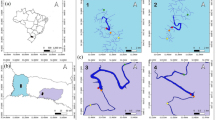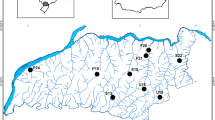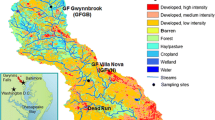Abstract
The dynamics of leaf litter transport and retention in two contrasting reaches in the Njoro River, Kenya, is reported, analysed and discussed. The study focussed on two aspects: experimental leaf litter transport and retention in the Maryjoy and Turkana reaches which differ in structural heterogeneity and natural leaf litter transport in the two reaches. Leaves of Dombeya goetzenii, Syzygium cordatum and Grewia forbesii were dyed differently with ‘Herbol®’ dyes and used to elucidate the dynamics of leaf transport and retention. Experimentally, about 40% of each of the three leaf species released into the water column travelled beyond the experimental 50-m mark in the Maryjoy reach (devoid of major retention structures) and about 95% of the leaves were retained within the Turkana reach (with major retention structures) and never reached the 50-m mark. Based on the calculated average leaf travel distance (1/k), the leaves of D. goetzenii could have drifted 10–113 m in the Turkana reach and between 60 and 127 m in the Maryjoy reach. The transport trends of the three leaf species were reach- but not leaf species-specific. The efficiency of trapping the drifting leaves differed from one retention structure to another in both reaches. Rock outcrops and debris dams were the main descriptors of the stream heterogeneity in the Turkana reach and retained about 55% and 20% of the experimental leaves, respectively. The leaves of S. cordatum dominated the leaf litter transported naturally within the two reaches, contributing 214.4±18.7 g d−1 to 274.1±36.8 g d−1 (± standard error) of the leaf litter biomass in the Turkana reach. It was estimated that 640.9 kg of leaf litter are exported to Lake Nakuru by the Njoro River annually.
Similar content being viewed by others
References
Basaguren, A., A. Elosegui & J. Pozo, 1996. Changes in trophic structure of benthic macroinvertebrate communities associated with food availability and stream flow variations. Int. Rev. ges. Hydrobiol. 81: 79–91.
Bilby, R. E. & G. E. Likens, 1980. Importance of organic debris dams in the structure and function of stream ecosystems. Ecology 61: 1107–1113.
Bretschko, G., 1990. The dynamic aspect of coarse particulate organic matter (CPOM) on the sediment surface of a second order stream free of debris dams (Ritrodat-Lunz study area). Hydrobiologia 203: 15–28.
Bretschko, G., 1995. Tropical River Ecology Initiative. First workshop, Egerton University, Njoro, Kenya. 31 January-18 February 1994: 92 pp.
Bretschko, G., 1996. Tropical River Ecology Initiative. Second workshop, Egerton University, Njoro, Kenya. 3–23 September 1995: 120 pp.
Bretschko, G. & D. Dudgeon, 1996. Allochthonous inputs and land-water interactions in seasonal streams: tropical Asia and temperate Europe. Pers. trop. limnol: 167–179.
Cariss, H. & M. Dobson, 1997. Transport and retention of detritus in upland streams: a comparison of an open stream and an adjacent wooded site. Limnetica 13: 85–91.
Cummins, K. W. & M. J. Klug, 1979. Feeding ecology of stream invertebrates. Ann. Rev. Ecol. Syst. 10: 147–72.
Cummins, K. W., G. L. Spengler, G. M. Ward, R. M. Speaker, R. M. Ovink, D. C. Mahan & R. L. Mattingly, 1980. Processing of confined and naturally entrained leaf litter in a woodland stream ecosystem. Limnol. oceanogr. 25: 952–957.
Cummins, K. W.,M.A. Wilzbach, D. M. Gates, J. B. Perry & W.B. Talaiffero, 1989. Shredders and riparian vegetation. Bioscience 39: 24–30.
Dale, I. R. & P.J. Greenway, 1961. Kenya Trees and Shrubs. Robert Maclehose & Co. Publishers, London: 654 pp.
Dobson. M., A. G. Hildrew, A. Ibbotson & J. Garthwaite, 1992. Enhancing litter retention in streams: do altered hydraulics and habitat area confound field experiments? Freshwat. Biol. 28: 71–79.
Ehrman, T. P. & G. A. Lamberti, 1992. Hydraulic and particulate matter retention in a 3rd-order Indiana stream. J. n. am. Benthol. Soc. 11: 341–349.
Harvey, C. J., B. J. Peterson, W. B. Bowden, L. A. Deegan, J. C. Finlay, A. E. Hershey & M. C. Miller, 1997. Organic matter dynamics in the Kuparuk River, a tundra river in Alaska, U.S.A. J. n. am. Benthol. Soc. 16: 18–23.
Iversen, T. M., J. Thorup & J. Skriens, 1982. Inputs and transformation of allochthonous particulate organic matter in headwater stream. Holarc. Ecol. 5: 10–19.
Jones, J. B. & L. A. Smock, 1991. Transport and retention of organic particulate organic matter in two low-gradient headwater streams. J. n. am. Benthol. Soc. 10: 115–126.
Leichtfried, M., 1998. Proteins: a very important fraction of particulate organic matter in riverbed sediments. In Helesic, J. & G. Bretschko (eds), Advances in River Bottom Ecology. Backhuys Publ., Leiden, NL: 65–76.
Mathooko, J. M., 1995. The retention of plant course particulate organic matter at the surface of the wet-store and dry-store zones of the Njoro River, Kenya. Afr. J. Ecol. 33: 151–159.
Mathooko, J. M. & S. T. Kariuki, 2000. Disturbances and species distribution of the riparian vegetation of a Rift Valley stream. Afr. J. Ecol. 38: 123–129.
Mathooko, J. M., C. M. M'Erimba & M. Leichtfried, 2000. Decomposition of leaf litter of Dombeya goetzenii in the Njoro River, Kenya. Hydrobiologia 418: 147–152.
Mathooko, J. M. & P. E. Schmid, 1993. Spatial heterogeneity and gradients of organic matter resources (OMR) in a second-order stream (the Oberer Seebach, Lunz, Austria). Jber. Biol. Stn. Lunz 14: 58–74.
Rulik, M., 1995. The vertical distribution of macrozoobenthos in river bed sediments (Morava River, Czech Republic). Biologia 91: 129–142.
Smock, L. A., G. M. Metzler & J. E. Gladden, 1989. Role of debris dams in the structure and functioning of low-gradient headwater streams. Ecology 70: 764–775.
Sokal, R. R. & F. J. Rohlf, 1995. Biometry. Freeman, New York: 887 pp.
Speaker, R.W., K. J. Luchessa, J. F. Franklin & S. V. Gregory, 1988. The use of plastic strips to measure leaf retention by riparian vegetation in a coastal oregon stream. Am. midl. nat. 120: 22–31.
Treadwell, S. A., I. C. Campbell & R. T. Edwards, 1997. Organic matter dynamics in Keppel Creek, southeastern Australia. J. n. am. Benthol. Soc. 16: 58–61.
Triska, F. J., J. R. Sedell & S. V. Gregory, 1982. Coniferous forest streams. In Edmonds, R. L. (ed.), Analysis of Coniferous Forest Ecosystems in theWestern United States. Hutchinson Ross Publ. Co., Stroudsburg, Pa.: 292–332.
Wallace, J. B. & J. R. Webster, 1996. The role of macroinvertebrates in stream function. Ann. rev. entomol. 41: 115–139.
Webster, J. R. & J. L. Meyer, 1997. Stream organic matter budgets. J. n. am. Benthol. Soc. 16: 3–161.
Young, S. A., W. P. Kovalak & K. A. Del Signore, 1978. Distances traveled by autumn-shed leaves introduced into a woodland stream. Am. midl. nat. 100: 217–222.
Author information
Authors and Affiliations
Rights and permissions
About this article
Cite this article
Mathooko, J.M., Morara, G.O. & Leichtfried, M. Leaf litter transport and retention in a tropical Rift Valley stream: an experimental approach. Hydrobiologia 443, 9–18 (2001). https://doi.org/10.1023/A:1017542617696
Issue Date:
DOI: https://doi.org/10.1023/A:1017542617696




